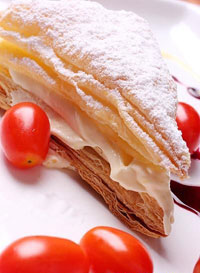Holiday feasts for the family
Updated: 2007-02-12 09:02
 Part of the fun of the Spring Festival is the huge feast on the night before the holiday kicks off.
Part of the fun of the Spring Festival is the huge feast on the night before the holiday kicks off.
Admittedly, thinking about food all the time might suggest that one may be in fact a glutton; but how do you not salivate when faced with the prospect of an overburdened table supporting plates and plates of mouth-watering delicacies?
Legend has it that in spring, a fearsome beast known as the nian, which uses the same character for "year," would emerge from the sea and terrorize common folk.
The phrase used to describe the New Year, guo nian, also signifies the passing of the beast.
It is believed that this started the tradition of red decorations and the setting off of firecrackers. According to the aforementioned folk tale, the color and cacophony was successful in keeping the beast at bay, and the practice has carried on to this day.
The northern and southern Chinese versions of lion dance, a familiar sight throughout the festival proper, are also said to be reenactments of the taming of the monstrosity.
Another tradition is the reunion dinner. It is commonplace for Chinese to work away from their families and this annual meal is often the only time close kin can sit down together to eat as a group.
As such, the meal consists of fare that can barely be described as run-of-the-mill. No expense is spared as the success of the year gone by is celebrated and the hopes for a prosperous annum are distilled into a lavish spread that features such dishes as shrimp, abalone and shark's fin, among others.
Such a feast requires hours of preparation, a luxury that most can barely afford in this city that never slows. It makes sense to book a table or two for parents, uncles, aunts and cousins in a fancy hotel to enjoy a hassle-free dinner to usher in the upcoming Year of the Pig.
Ai Mei at the Le Royal Meridien Shanghai is offering 10- and 11-course set menus until February 25. These must be booked for tables of 10 people, and range from 2,380 yuan (US$307) to 5,380 yuan for a more lavish experience.
Those preferring to enjoy a more intimate dinner can sample a 10-course "Prosperity Menu" for 388 yuan. This includes dishes such as suckling pig, double-boiled shark's fin soup and steamed Mandarin fish, among others.
In Southeast Asia, overseas Chinese enjoy eating yu sheng, or raw fish salad, during the meal. Originally practiced by southern Chinese fishermen, the Pudong Shangri-La will be promoting the salad that is tossed (referred to as lo hei) whilst making auspicious wishes.
The dish costs between 288 yuan and 588 yuan for the salmon version, and between 488 yuan and 888 yuan for abalone. The smallest size feeds between two and four people and the larger offerings are enough for 10.
The property's Chinese restaurant is also offering two set menus, priced at 488 yuan per person and 588 yuan per person, respectively.
Both require bookings of at least eight.
The Hilton Shanghai is offering special sets starting at 3,188 yuan per table of 10 through February.
The Huashan Road property is selling an exquisitely-packaged glutinous rice cake (nian gao) for 188 yuan. Shaped like a fish, the treat is a play on the word yu, which means fish, and sounds like the Chinese word for "abundance."
The best part about feasting in the comfort of hotel restaurants? Not having to do the dishes afterwards. All the better, as after such a lavish meal, one may find oneself considerably less mobile.
Hilton Shanghai
Address: 250 Huashan Road
Tel: 021-6248-7777 ext 1886
Le Royal Meridien Shanghai
Address: 789 Nanjing Road E.
Tel: 021-3318-9999 ext 770
Pudong Shangri-La
Address: 33 Fucheng Road
Tel: 021-5888-3697
|
||
|
||
| Eating out:
Arriba arrives in the Wu
Bars&Cafes: Mare's milk a-go-go Weekend&Holiday: Ancient sites re-open after renovation Shopping: Jimmy Choo comes What's on: New shows on stage |
|
||
| Eating out:
Moroccan roll
Bars&Cafes: A boonna in training Weekend&Holiday: Pop power Shopping: LV boutique in E. China closed for disqualification What's on: Jazz-infused journey through Kunqu Opera |

